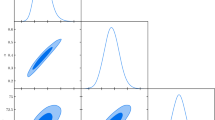Summary
We study aR 2 model of gravity with torsion in a closed Friedmann-Robertson-Walker universe. The model is cast in Hamiltonian form subtracting from the original Lagrangian the total time derivative off KfR, wheref K is proportional to the trace of the extrinsic curvature tensor, andf R is obtained differentiating the Lagrangian with respect to the highest derivative. Torsion is found to lead to a primary constraint linear in the momenta and a secondary constraint quadratic in the momenta, and the full field equations are finally worked out in detail. Problems to be studied for further research are the solution of these equations and the quantization of the model. One could then try to study a new class of quantum-cosmological models with torsion.
Riassunto
Viene studiato un modelloR 2 della gravitazione con torsione in un universo Friedmann-Robertson-Walker chiuso. Il modello è posto in forma hamiltoniana sottraendo dalla Lagrangiana originaria la derivata temporale totale dif KfR, ovef K è proporzionale alla traccia del tensore di curvatura estrinseco, ef R è ottenuto differenziando la Lagrangiana rispetto alla derivata di ordine piú elevato. Si trova che la torsione conduce ad un vincolo primario lineare negli impulsi e a un vincolo secondario quadratico negli impulsi, e le equazioni di campo sono infine derivate in dettaglio. I problemi da studiare per estendere la ricerca sono la soluzione di queste equazioni e la quantizzazione del modello. Si potrebbe allora tentare di studiare una nuova classe di modelli di cosmologia quantistica con torsione.
Резюме
Мы исследуемR 2 модель гравитации с кручением в замкнутой Вселенной фридмана-Робертсона-Уолкера. Эта модель дает Гамильтониан, как результат вычитания из исходного Лагранжиана полной временной производнойf KfR, гдеf K является пропордиональной следу несобственного тензора кривизны иf R получается при дифференцировании Лагранжиана по вычшей производной. Мы получаем, что кручение приводит к первичному ограничению, линейному по импульсам, и к вторичному ограничению, квадратичному по импульсам. Затем получаются полные полевые уравнения. Проблемы дальнейших исследований представляют поиски решения этих уравнений и получение модели квантования. Затем можно попытаться исследовать новый класс квантовых космологических моделей с кручением.
Similar content being viewed by others
References
F. W. Hehl, P. von der Heyde, G. D. Kerlick andJ. M. Nester:Rev. Mod. Phys.,48, 393 (1976).
A. Trautman:Symp. Math.,12, 139 (1973).
C. Stornaiolo: Ph. D. Thesis (University of Naples, 1987).
E. A. Lord andP. Goswami:J. Math. Phys. (N.Y.),29, 258 (1988).
P. K. Smrz:J. Math. Phys. (N.Y.),28, 2824 (1987).
D. Ivanenko andG. Sardanashvily:Pramana,29, 21 (1987).
M. Demianski, R. de Ritis, G. Platania, P. Scudellaro andC. Stornaiolo:Phys. Lett. A,116, 13 (1986).
J. D. Mc Crea: inDifferential Geometric Methods in Mathematical Physics, inProceedings of the XIV International Conference, edited byP. L. García andA. Pérez-Rendón (Springer-Verlag, Berlin, 1987), p. 222.
E. Sezgin andP. van Nieuwenhuizen:Phys. Rev. D,21, 3269 (1980).
R. Rauch andH. T. Nieh:Phys. Rev. D,24, 2029 (1981).
M. Gasperini:Phys. Lett. B,205, 517 (1988).
R. Kuhfuss andJ. Nitsch:Gen. Rel. Grav.,18, 1207 (1986).
I. A. Nikolic:Phys. Rev. D,30, 2508 (1984).
V. Szczyrba:Phys. Rev. D,36, 351 (1987).
V. Szczyrba:J. Math. Phys. (N.Y.),28, 146 (1987).
S. W. Hawking andJ. C. Luttrell:Nucl. Phys. B,247, 250 (1984).
G. T. Horowitz:Phys. Rev. D,31, 1169 (1985).
R. de Ritis, P. Scudellaro andC. Stornaiolo:Phys. Lett. A,126, 389 (1988).
A. J. Fennelly, J. C. Bradas andL. L. Smalley:Phys. Lett. A,129, 195 (1988).
M. Pilati:Nucl. Phys. B,132, 138 (1978).
P. A. M. Dirac:Lectures on Quantum Mechanics (Belfare Graduate School of Science, Yeshiva University, New York, N.Y., 1964).
P. Baekler andE. W. Mielke:Fortschr. Phys.,36, 549 (1988).
D. Boulware in:Quantum Theory of Gravity, edited byS. M. Christensen (Adam Hilger, Bristol, 1984), p. 267.
I. L. Buchbinder andS. L. Lyahovich:Class Quantum Grav.,4, 1487 (1987).
B. K. Berger, D. M. Chitre, V. E. Moncrieff andY. Nutkin:Phys. Rev. D,5, 2467 (1972).
H. Goenner andF. Muller-Hoissen:Class. Quantum Grav.,1, 651 (1984).
J. B. Hartle andS. W. Hawking:Phys. Rev. D,28, 2960 (1983).
S. W. Hawking:Nucl. Phys. B,239, 257 (1984).
G. Esposito andG. Platania:Class. Quantum Grav.,5, 937 (1988).
M. Pollock:Nucl. Phys. B,306, 931 (1988).
R. C. Myers andJ. Z. Simon:Phys. Rev. D,38, 2434 (1988).
O. Alvarez: Senior Thesis (Princeton University, Princeton, N.J., 1974).
L. Castellani, P. Van Nieuwenhuizen andM. Pilati:Phys. Rev. D,26, 352 (1982).
R. Di Stefano andR. T. Rauch:Phys. Rev. D.,26, 1242 (1982).
J. Isenberg andJ. Nester: inGeneral Relativity and Gravitation, edited byA. Held (Plenum Press, New York, N.Y., 1980), p. 23.
J. W. York:Phys. Rev. Lett.,28, 1082 (1972).
G. W. Gibbons andS. W. Hawking:Phys. Rev. D,15, 2752 (1977).
J. W. York:Found. Phys.,16, 249 (1986).
Author information
Authors and Affiliations
Additional information
Переведено редакцией.
An erratum to this article is available at http://dx.doi.org/10.1007/BF02728667.
Rights and permissions
About this article
Cite this article
Esposito, G. Hamiltonian structure of a Friedmann-Robertson-Walker universe with torsion. Nuov Cim B 104, 199–212 (1989). https://doi.org/10.1007/BF02906317
Received:
Published:
Issue Date:
DOI: https://doi.org/10.1007/BF02906317




